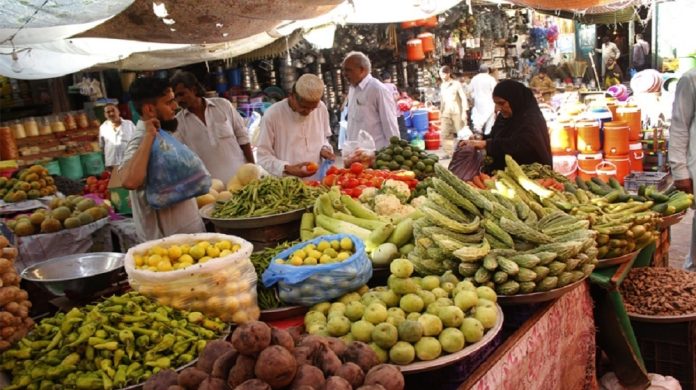Staff Report
ISLAMABAD: The Ministry of Finance has warned that headline inflation is expected to remain at an “elevated level” in the coming months, adding to the concerns of the public and the government.
In a latest economic update report, the Finance Ministry predicted that the consumer price index (CPI)-based inflation will be hovering at around 36-38% for April.
“Its key drivers are food and energy price hikes. Further, currency depreciation and rising administered prices have contributed to the jack-up of the overall price level. Although global commodity prices are showing a downward trend, however, are still on the higher side compared to the pre-pandemic level,” said the report.
It added that a slow recovery from flood-led damages has caused the supply of essential crops to remain short of do-mestic requirements consequently intensifying inflation.
Even though the State Bank of Pakistan (SBP) is enacting a contractionary monetary policy, inflationary expectations are not settling down. However, the federal government, in liaison with provincial governments, is closely monitoring the demand-supply gap of essential items and taking necessary measures to ease inflationary pressures.
According to the report, Pakistan’s economy is still facing significant challenges characterised by elevated inflation and a slowdown in economic activities.
However, some positive signals appear as a result of the government’s stabilisation policies as the current account of the balance of payment (BOP) turned into a surplus. This might improve the external financing constraint, contribute to more exchange rate stability, and promote confi-dence in the economy. “Further, successful completion of the IMF [International Monetary Fund] programme will pave the way to attract more capital inflows, further stabilisation in the exchange rate and alleviating the inflationary pressures,” the Ministry of Finance hopes.
During the Kharif 2023, the availability of inputs regarding seeds, agriculture credit and fertilisers will remain satisfacto-ry.
The Pakistan Met Department (PMD) said that slightly above-normal rains are expected in the next three months (April-June 2023), particularly in the upper half of the country. Lesser rains are expected during the month of June. The temperature may remain slightly above normal in most parts of the country. A gradual rise in temperature will ac-celerate the snow melt in the northern areas. The seasonal rainfall may provide water for crops in the main rain-fed areas while lower parts of the country will remain slightly deficient during the season of Kharif.
Industrial activity, measured by the large-scale manufacturing (LSM) index, is the sector that is most exposed to ex-ternal conditions. Its cyclical pattern is well positively correlated with the cyclical position of Pakistan’s main trading partners.
Since the beginning of the current fiscal year, LSM activity is recorded below its natural capacity level. The same obser-vation applies to the cyclical position in Pakistan’s main export markets. The cyclical recession in Pakistan’s manufactur-ing output was also exacerbated by the necessary policy measures to offset the macroeconomic imbalances.
In recent months, LSM output remains considerably below its potential, but some bottoming-out seems to take place. This is also apparent from the seasonally adjusted LSM activity, which shows stabilisation in recent months. In March, LSM output is expected to have increased as compared to February due to positive seasonal effects. But due to the high base effect, the YoY LSM may still be marginally negative.
For the month of March BoP data reveals that the trade deficit in goods and services declined by 9.1% on a MoM basis and 54% on a YoY basis. Some positive developments have been observed in the month of March as exports of goods and services increased by 9.5% and imports of goods and services increased by 2.3%. High growth in exports has offset the impact of the increase in imports as the trade deficit remains contained.
Remittances increased by 27% on a MoM basis to $2.5 billion in March 2023 as compared to $1.99 billion in February 2023, due to an improved situation after exchange rate adjustments, Ramadan and Eid factors played an instrumental role to attract higher proceeds. All the above favourable factors have been translated into the current account which turned into a surplus of $654 million in the month of March, this is the level observed after November 2020.
For the month of April, it is expected that imports will increase somewhat at a higher level as compared to March due to the government’s decision for some relaxation in pro-growth imports, to stimulate domestic economic activities.
However, remittances will remain at the same level as observed in March. Accordingly, all these factors will contribute to curtailing the overall current account deficit.
Amidst unprecedented challenges due to domestic and global economic situations, fiscal consolidation efforts are on track. The objective is not only to create much-needed fiscal buffers but also to restore macroeconomic stability.
The effective implementation of consolidation measures contributed to a sharp increase in revenues from both tax and non-tax collection while containing overall spending growth due to a large drop in non-markup expenditures.
Despite the improvement, risks to the financial sector still persist. Such as the Federal Board of Revenue (FBR) tax col-lection although growing at 18%, however, it remained below the target set for the first nine months of the current fiscal year owing to a slowdown in domestic economic activity and import compression.
On the expenditure side, in spite of reducing non-markup spending, higher policy rates both at the domestic and glob-al levels have been attributed to higher markup payments.
Under these circumstances, the government has a daunting task to follow effective revenue mobilisation and cautious expenditure management strategy to end the current fiscal year with a substantial decline in fiscal deficit as compared to last year.



